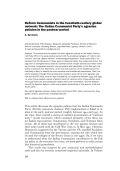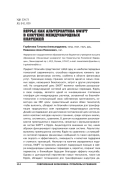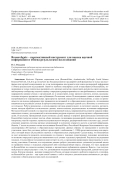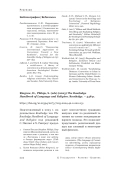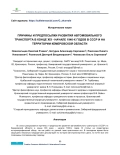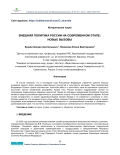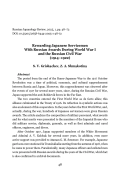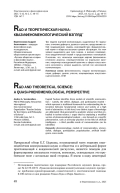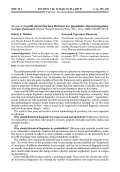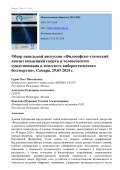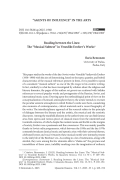This article aims to explain the main agrarian policies of the Italian Communist Party (PCI) in the early postwar period with the analytical category of “reform communism” and the “global network” methodological approach. These tools help to understand the PCI decisions in these years in historical rather than polemical terms. The argument is strengthened by archival materials which include Central Committee meeting minutes, congresses records, internal reports and pamphlets. In the first part, the author introduces the ‘New Party’, which was the evolution of the traditional Communist Party of Italy, to identify its main historical and intellectual coordinates. Then, the article analyzes through those analytical innovations some of the main agrarian policies that the PCI tried, more or less successfully, to implement between 1944 and 1947, i. e. when there existed a series of governments of national unity. These policies were the 1944 Gullo Law, the subsequent organs like Land Committees, and the debates around the Agrarian Reform, which are analyzed respectively in the second, third and fourth parts.
Предмет: блокчейн представляет собой одну из наиболее передовых технологий современности, способную кардинально изменить традиционную финансовую систему, особенно в области финансовых услуг. Транзакции между странами остаются одной из самых сложных задач, касающихся безопасности, затрат и других регулирований. На сегодняшний день SWIFT является наиболее распространенной международной системой для денежных переводов. Ripple, в свою очередь, является одной из инновационных платежных платформ для международных расчетов, основанной на блокчейн-технологии и использующей свою собственную криптовалюту, известную как XRP. Цель: сравнительный анализ обеих технологий, чтобы выяснить, обладает ли блокчейн потенциалом для трансформации традиционных схем проведения международных расчетов. Дизайн исследования: для достижения поставленной цели использовался комплекс методов научного познания, среди которых анализ, синтез, системность, сравнение. В данном исследовании рассматриваются преимущества и недостатки, связанные с функционированием систем SWIFT и Ripple. Акцентируется внимание на том, каким образом функционирует предложенная новая система. Результаты: выявлены преимущества системы Ripple по сравнению с устоявшейся системой передачи финансовых сообщений по таким критериям, как скорость и эффективность, ликвидность и валютная поддержка и стоимость транзакций. Несмотря на наличие определенных недостатков, SWIFT по-прежнему занимает лидирующие позиции в сфере международных денежных переводов и, вероятно, сохранит свое первенство в ближайшем будущем благодаря эффекту масштаба. Однако в долгосрочной перспективе новые технологии, такие как Ripple, обладают потенциалом для трансформации индустрии денежных переводов и могут сильно повлиять на транзакции между странами в финансовом секторе.
Введение. Научные социальные сети (ResearchGate, Academia. edu, SciPeople, Social Science Research Network, CoLab и др.) получают все большее развитие и расширяют свой функционал не только как платформы для научной коммуникации, но и как полноправные инструменты для поиска разнородной информации и обмена результатами исследований. Одной из наиболее популярных сетей в мире является ResearchGate, позволяющая не только значительно расширить сеть научных контактов и представить результаты своих исследований научному сообществу, получить оценку и определить распространенность и востребованность тематических направлений, влияние ученых и организаций, но и осуществлять поиск научного контента, изучать исследовательские интересы, продвигать свои публикации.
Постановка задачи. В исследовании ставятся задачи изучения востребованности и функциональных характеристик научной социальной сети ResearchGate, а также ее применимости для поиска информации при проведении исследований и в образовательных процессах, отслеживания вовлеченности российских ученых в научную коммуникацию с помощью данной сети.
Методика и методология исследования. Работа проводилась с использованием методов сравнительного и системного анализа, математических методов обработки статистических данных, контент-анализа документальных источников информации. Методологической основой стал практико-ориентированный подход, направленный на развитие навыков информационного поиска у исследователей и использование ресурсов открытого доступа в научных и образовательных целях.
Результаты. Проведенный анализ позволил сделать выводы о широких функциональных возможностях ResearchGate (загрузка полных текстов, обмен данными, отслеживание рекомендаций, подписка на аналогичные материалы, участие в группах, оценка исследовательского интереса, расширенный поиск в системе и др.), способствующих развитию системы научных коммуникаций и получению открытого доступа к научной информации.
Выводы. С целью изучения степени использования ResearchGate в Российской Федерации были выявлены и проанализированы 284 научных и образовательных учреждения. Данные собраны по учреждениям и количеству участников, далее был составлен рейтинг организаций с наибольшим (> 1000) представительством пользователей, в который вошло 28 российских научных и образовательных учреждений. Сделан вывод, что ResearchGate не дает возможности проводить исследование по странам с помощью существующих поисковых механизмов, но позволяет определить тренды по вовлечению в сеть ученых отдельных учреждений. Результаты исследования показали, что российские пользователи присутствуют в сети, а учреждения неравномерно представлены по количеству участников. Отмечено, что полученные данные требуют дополнительного уточнения (детальный анализ по профилям ученых и отдельных учреждений либо полномасштабный опрос), учитывая, что часть профилей на ResearchGate не создается самими учеными, а автоматически добавляются сервисом. Вместе с тем полученный результат свидетельствует о том, что для выявления тенденций вовлечения учреждений, данный метод применим. В списке лидеров – ведущие университеты России, которые попадают в рейтинги открытости, и платформа ResearchGate для них – еще один способ заявить о себе и получить дополнительные возможности для представления и обмена результатами своих исследований.
Для цитирования: Раренко М. Ringrow, H., Pihlaja, S. (eds) (2024) The Routledge Handbook of Language and Religion. Routledge. — 448 p. Государство, религия, церковь в России и за рубежом. 2024;42(2):222-231. https://doi. org/10.22394/2073-7203-2024-42-2-222-231
The article reveals the reasons and prerequisites for the development of automobile transportation in the USSR and in the Kemerovo region in the late XIX century - early 1940-s. The article does not provide a historiographical review, as there are practically no works on this topic. Recently, there have been defended several PhD theses on the history of motor transportation, but almost all of them are devoted to the post-war period. This article shows mainly the reasons and prerequisites for the emergence and development of road transport in the interwar period. The main reason for the development of road transport was the development of industry, industrialization. Therefore, freight transportation was developed first of all.
The article shows that in recent years the Russian Federation has sought to pay more attention to the protection of its spiritual and moral values and cultural heritage. Under the leadership of Vladimir Putin, the country opposes attempts to forget and destroy its historical past and opposes manifestations of Russophobia. In addition, Russia actively supports efforts to preserve traditional family values. One of the key areas of Russia’s policy is the protection of Russian identity, Russian sport and the Russian Orthodox Church. Russia is ready to cooperate with all sane forces of the West and does not seek isolation from it. Moscow hopes that Western elites will someday realize the senselessness of confrontation and accept the concept of a multipolar world. It is necessary to abandon anti-Russian policy and the desire for U. S. dominance, which could have a positive impact on the security and well-being of Europe.
The period from the end of the Russo-Japanese War to the 1917 October Revolution was a time of political, economic, and cultural rapprochement between Russia and Japan. Moreover, this rapprochement was observed after the events of 1917 for several more years, since, during the Russian Civil War, Japan supported the anti-Bolshevik forces in the Far East.
The two countries entered the First World War as de facto allies; this alliance culminated in the Treaty of 1916. Its reflection in symbolic actions was also an element of this cooperation. In the years before the First World War, and, actually, during the war, hundreds of Japanese servicemen were given Russian awards. The article analyzes the composition of military personnel, what awards and for what merits were presented to the members of the Imperial House who did military service, diplomats, generals, as well as fleet admirals and naval officers, engineers, and divers.
After October 1917, Japan supported members of the White Movement and Admiral A. V. Kolchak for several more years. In addition, even more active support was provided to Ataman G. M. Semenov. For example, Japanese garrisons were stationed in Transbaikalia starting from the autumn of 1918, when he came to power there. Paradoxically, many Japanese officers and enlisted men were presented with Russian awards during the years of the Civil War, which fact is also confirmed in archival documents.
Три модели научной коммуникации, выделяемые Е. Г. Цурканом, а именно дефицита, диалога и участия, представляют собой традиционную модель взаимодействия фундаментальной науки и общества высокого уровня абстракции. На этом уровне выделяются два типа знания, а именно генерируемого академической наукой и представленного технонаукой. Я полагаю, что, используя некоторую версию феноменологического анализа, сосредоточенную на отдельном явлении, например повседневной практике в сфере искусственного интеллекта, можно выделить третий тип возможной коммуникации.
The paper is concerned with the numerical simulation of the coal gasification process in an entrained flow of high-temperature air-steam mixture. Due to the high initial temperature and the process staging, it is possible to obtain an efficient gasification process. The study aims to examine the stationary conditions of staged gasification process by using a mathematical model based on one-dimensional heat and mass transfer equations with combined submodels to describe physicochemical transformations. The simulation makes it possible to determine the boundaries of the transition from the “single-stage” to the “two-stage” gasification conditions and identify the most promising ones.
This publication constitutes a comprehensive account of the panel discussion entitled “Philosophical and Ethical Analysis of the Concepts of Death and Human Existence in the Context of Cybernetic Immortality” which transpired within the confines of the international scientific symposium “The Seventh Lemovsky Readings” held in Samara from March 28th to 30th, 2024. The aforementioned panel discussion, which congregated scores of erudite scholars representing preeminent research institutions across the Russian Federation, emerged as one of the cardinal events of the conference. Eminent Russian academics hailing from multifarious domains of knowledge engaged in a profound deliberation on the potentialities of cybernetic immortality, the conundrums associated with the transference of human consciousness and identity into the virtual realm, as well as the ethical and philosophical quandaries engendered by the transfiguration of the conceptualization of the notions of mortality and the natural life cycle. The roundtable delved into the technological feasibilities and perils of engendering digital doppelgangers, the preservation of individuality after corporeal demise, as well as the plausible ramifications of the technological modification of the human essence.
Представлено исследование произведений позднесоветского писателя Венедикта Васильевича Ерофеева (1938-1990) с целью определить на основе типов, количества и гибридных характеристик музыкальных отсылок, присутствующих в его творчестве, можно ли говорить о последовательном «музыкальном подтексте» как одной из ключевых его тем. Действительно, аналогично тому, что исследовали ученые в области религиозной и литературной тематики, страницы этого уникального автора насыщены скрытыми отсылками к нескольким популярным произведениям и фигурам российской, советской и международной музыкальной сцены. Методологически автор опирается на концепцию теории семиосферы Ю. Лотмана и намеревается воссоздать специфическую семиотическую атмосферу, в которой родились произведения Ерофеева, принимая во внимание также мемуары современников, критические материалы и биографию писателя. Междисциплинарный подход исследования связан с принципом диалога между литературными и художественными, музыкальными и семиотическими дискурсами. Среди многочисленных аллюзий в текстах автора можно в первую очередь выделить известные арии из опер и различные произведения классической музыки XIX и XX вв., которыми, несмотря на скромные средства и жизнь на обочине общества, Ерофеев был увлечен и тонким знатоком которых он являлся. Это было возможно в значительной степени благодаря советским радиопрограммам, в которых постоянно транслировалась подобная музыка, эти музыкальные мотивы интенсивно присутствовали в повседневной жизни людей брежневской эпохи. По многим свидетельствам, наряду с алкоголем, они были среди немногих составляющих жизни, способных скрасить серость тех лет. Основные объекты исследовательского интереса автора статьи - музыкальные образы, присутствующие в знаменитой поэме в прозе «Москва - Петушки» (1970) и в трагедии «Вальпургиева ночь, или “Шаги Командора”» (1985), а также в «Записных книжках» из сборника «Бесполезное ископаемое» (2001), в юношеском дневнике писателя «Записки психопата» (1956-1957) и в незавершенной ритмической прозе «Благая весть» (1962).
This paper studies the works of the late-Soviet writer Venedikt Vasilyevich Erofeev (1938-1990) with the aim of determining, based on the types, quantity, and hybrid characteristics of the musical references present in them, if it is possible to speak of a consistent “musical subtext” as one of the fils rouges in his creative writing. In fact, similarly to what has been investigated by scholars about the religious and literary domains, the pages of this author sui generis are scattered with hidden references to several popular works and protagonists of the Russian, Soviet, and international music scene. Drawing upon the methodological point of view on the conceptualization of Lotman’s semiosphere theory, the article intends to recreate the peculiar semiotic atmosphere in which Erofeev’s works were born, considering also memoirs of contemporaries, critical materials and a recent biography of the writer. The interdisciplinary approach of the research relates to the principle of dialogue between the literary and the artistic, the musical and the semiotic discourses. Among the manifold allusions in the author’s texts one can find famous arias from operas and various pieces of classical music from the nineteenth and twentieth centuries, of which, despite his modest means and his life on the margins of society, Erofeev was a passionate and fine connoisseur. This was mainly possible thanks to Soviet radio programmes, which between the 1950s and the late 1970s constantly broadcast classical music and operatic arias: with their universal themes, celebrated heroes and vocal virtuosity these musical motifs were intensely present in the daily life of the Brezhnev era. According to a lot of testimonies, along with alcohol, they were among the few elements able to “shake out” the greyness and immobilism of those years, indelibly marking even the imagination of ordinary people. After a biographical contextualization of the author, the main areas of interest will be the musical elements present in the famous prose-poem Moskva - Petushki (1970) and in the tragedy Val’purgieva Noch’, ili “Shagi Komandora” (Walpurgis Night, or “The Steps of the Commander”, 1985). Secondly, some passages of the Notebooks from the collection Bespoleznoe iskopaemoe (Useless Fossil, 2001), of the writer’s youth diary Zapiski psichopata (Memoirs of a Psychopath, 1956-1957) and of the unfinished rhythmic prose Blagaja Vest’ (The Gospel, 1962) will be also taken into consideration.
